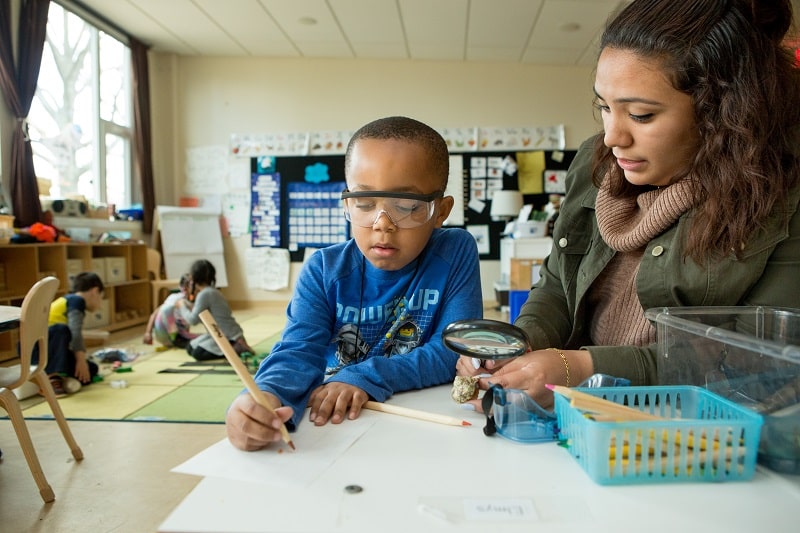In the world of personalized learning, there’s a longstanding tension over the goals of education. Making instruction adaptive to students’ needs and interests is good in principle, but sometimes that flexibility seems destined to come at the expense of solid student achievement gains as measured by standardized test scores. New research from Kennesaw State University in Georgia, however, provides promising evidence that personalized learning, when implemented with fidelity, “is effective for increasing academic achievement measured by standardized tests,” reports Education Week.
The report’s lead author, Dabae Lee, assistant professor at Kennesaw State, discussed with Education Week specific factors that differentiated personalized learning in learner-centered schools that performed well on standardized tests versus those that didn’t. These factors include: incorporating students’ own career goals and interests in personalized learning plans; forming close relationships between teachers and students; using technology collaboratively; and adopting a different mindset about teaching, learning, and instruction.
Identifying key factors to effectively personalize learning is important. But implementing organizational change to put them into practice can be challenging. Here, we offer strategies that can help schools implement personalized learning practices.
1. Use an opportunity frame to shift the mindset
“Pushing educators to adopt personalized learning while maintaining the negative consequences of a temporary drop in test scores may lead them to adopt it at the very surface level, which will not result in an increase in academic outcomes,” notes Lee in Education Week. Indeed, half-hearted implementation or top-down mandates without administrative support will likely lead to an eventual failure of any personalized learning initiative.
Research shows that when people frame a situation as an opportunity rather than a threat, they are much better at thinking flexibly and creatively as they figure out how to seize the opportunity.
How can administrators, educators, and parents make this mindset shift? First, accept that learning won’t happen as previously experienced. Then, look for the potential upsides of the paradigm change, rather than focusing on the risks. For example, putting learners at the center of instruction can help teachers improve how they communicate with students and their families and discover new ways to incorporate high-quality online learning tools into their instruction. Especially in the COVID era, there’s practical wisdom in seizing the moment to move toward learner-centered schooling.
2. Focus on increasing teacher capacity to build teacher-student relationships
Incorporating students’ career goals and interests into personalized learning plans depends upon teachers first forming closer relationships with their students to glean this information. Yet, the unfortunate reality is that thanks to the pandemic plus decades of new policies, best practices, and rising expectations, teachers are saddled with responsibilities that go well beyond the hours in a day—responsibilities that are more often chore-like (grading assignments) than supportive (providing real-time feedback).
When implemented thoughtfully and strategically, technology has the potential to relieve the stress related to many teachers’ day-to-day tasks by expanding their capacity in the classroom, allowing them both the time and the tools to make a significant, positive impact in each of their students’ lives. There are two potential ways technology can amplify teacher capacity: enhancing teachers’ effectiveness by helping them do work more quickly and efficiently, and enabling teachers to use new approaches in their work that were impossible or impractical previously. (See specific technology examples and learn more about expanding teacher capacity here.)
3. Look beyond digitization to use technology collaboratively
According to Kennesaw State’s study, high-performing personalized learning schools used an integrated technology system (e.g., learning management systems [LMS]), and trained teachers to support “recordkeeping, planning, learning, and assessment,” though teachers often used the technology in “a wider variety of ways.”
It’s important to clarify that while an LMS is a valuable tool for supporting personalizing learning, it won’t produce personalized learning on its own. A district, school, or classroom can incorporate technology without actually changing the conventional classroom model or the way students learn.
For an integrated technology system to have a fully transformative impact, it’s important to put the horse before the cart, or the paradigm shift before the technology. Teachers should also pair data-collecting strategies with helping students understand the purpose and relevance of their learning, consistently employ formative assessment strategies and respond to the results, and be able to offer students distinct paths to reaching meaningful learning goals. These skills are not unique to tech-supported classrooms—teachers have been employing these strategies without technology for years. But personalized approaches, with the help of technology, can bring these critical strategies to scale.
Kennesaw State’s research provides many other recommendations for employing a successful personalized learning approach, such as providing real-world opportunities for learning and community feedback (a strategy my colleague Julia Freeland Fisher has documented and provided potential solutions for as well). And though the study calls for more research to be conducted on personalized learning schools and their approaches within specific contexts, the factors identified in the study seem like critical considerations for any school to harness in order to move toward high-performing, personalized learning pathways.



